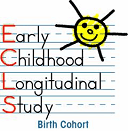Sharing Research Findings on Development from Birth to Age Two Years
 The NICHD, the NIH Office of Behavioral and Social Science Research (OBSSR), and the National Center for Education Statistics (NCES) within the U.S. Department of Education are hosting a three-day conference about the Early Childhood Longitudinal Study—Birth Cohort (ECLS-B), from May 8-10, 2007.
The NICHD, the NIH Office of Behavioral and Social Science Research (OBSSR), and the National Center for Education Statistics (NCES) within the U.S. Department of Education are hosting a three-day conference about the Early Childhood Longitudinal Study—Birth Cohort (ECLS-B), from May 8-10, 2007.
This unique study, started in 2000, includes a nationally representative sample of 14,000 children who were born in 2001. Researchers collected data on these children at birth, at age 9 months, at age two years (in 2003), in preschool (one year away from kindergarten, in 2005), and at kindergarten (2006 and 2007).
This conference focuses on findings using data from the birth through age two years collections—called the “birth cohort.” These data will provide critical information about development in diverse ethnic groups, variables that affect health and well-being, family factors that impact young children’s growth and development, and other topics. Speakers from the NIH and the Department of Education will address the conference on each of the three days. Researchers with expertise in early childhood health and development, as well as NIH and NCES staff, will serve as moderators to the speakers and paper discussants for the conference.
The ECLS-B is a collaboration among many federal agencies, including the NIH, the NCES, the Centers for Disease Control and Prevention, and the Health Resources and Services Administration, to name just a few. The children participating in the study come from diverse socioeconomic and racial/ethnic backgrounds with oversamples of Asian and Pacific Islander children, American Indian and Alaska Native children, Chinese children, twins, and low and very low birth weight children.
To learn more about the conference or the Study, visit the links below:
Originally Posted: May 7, 2007

 BACK TO TOP
BACK TO TOP